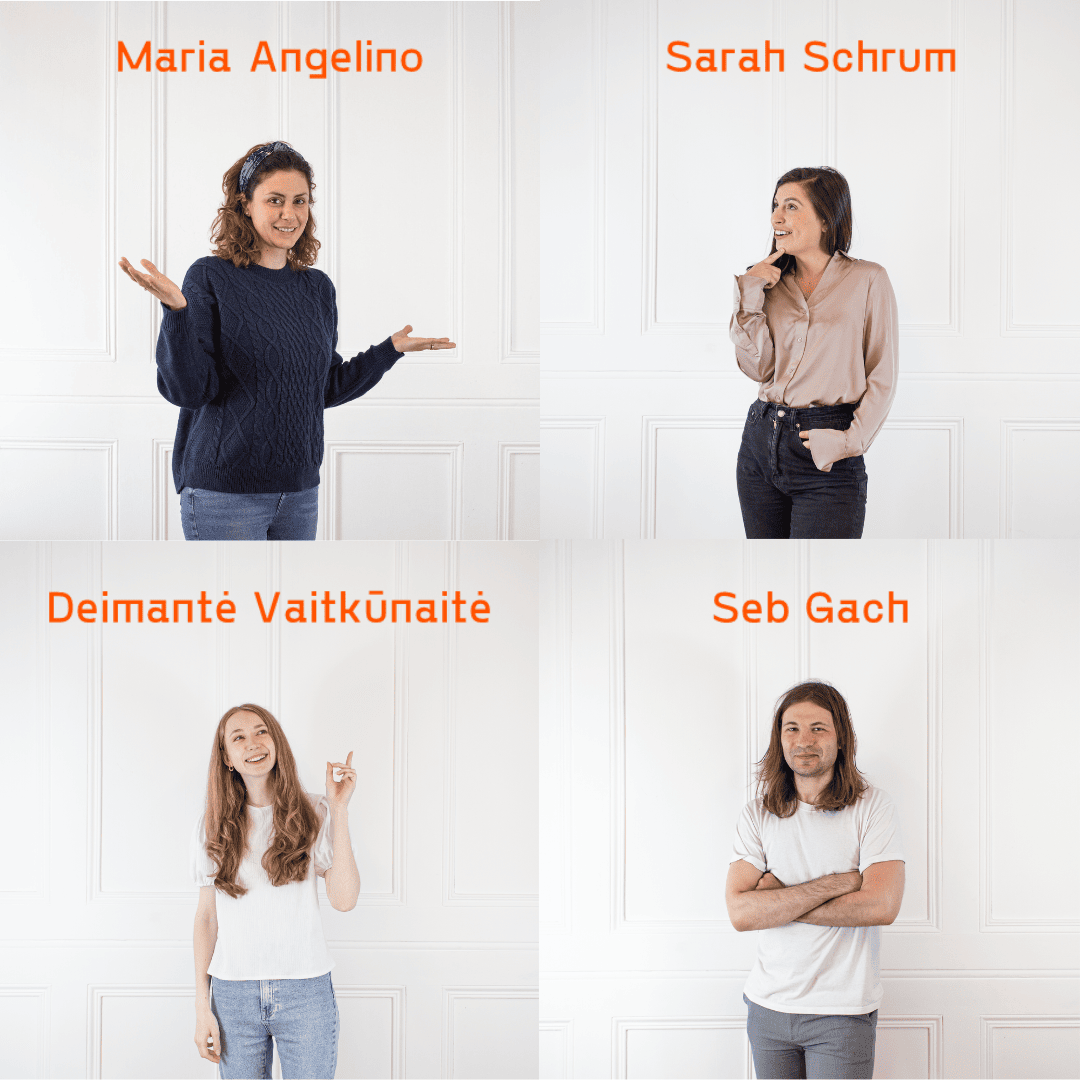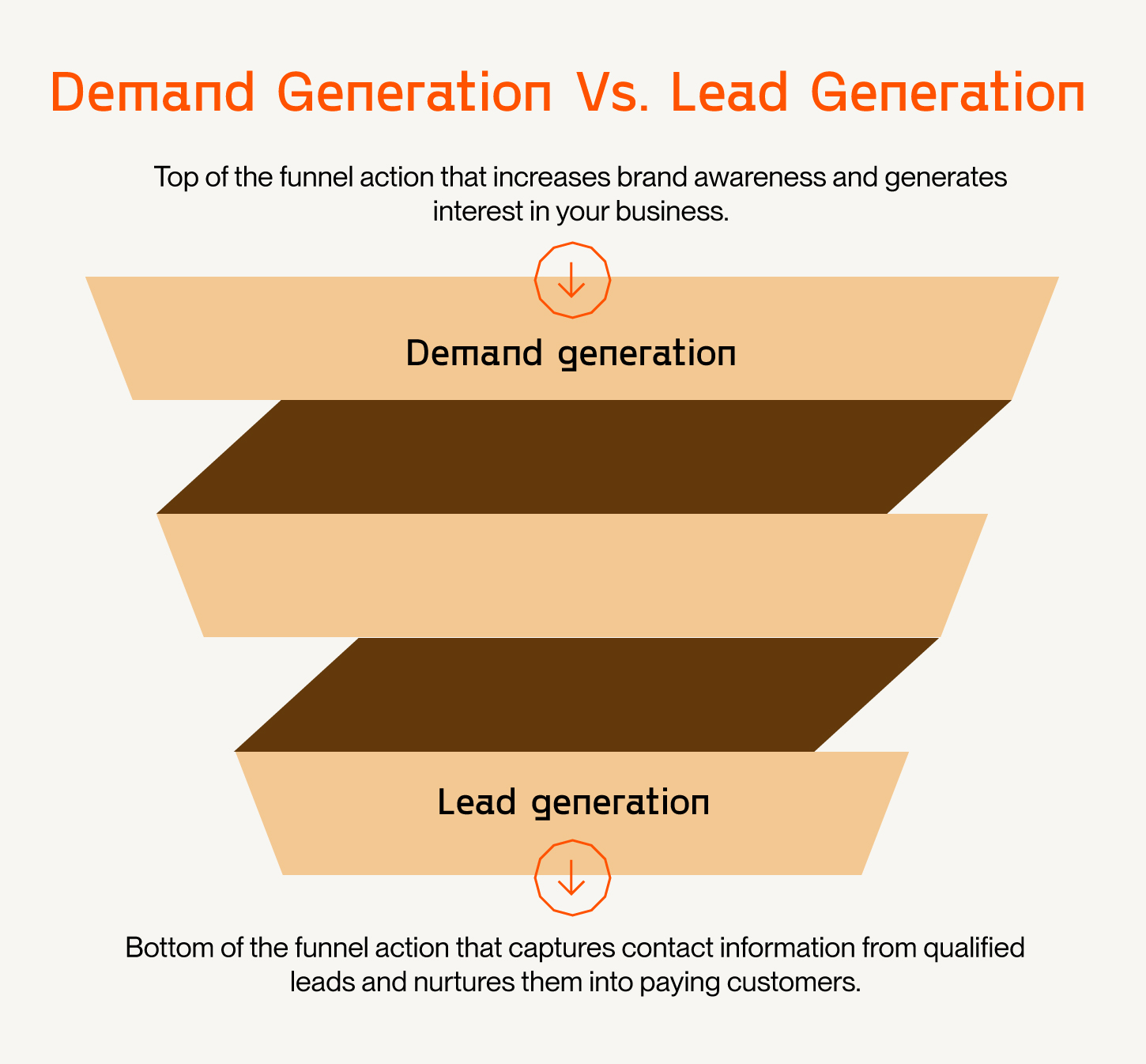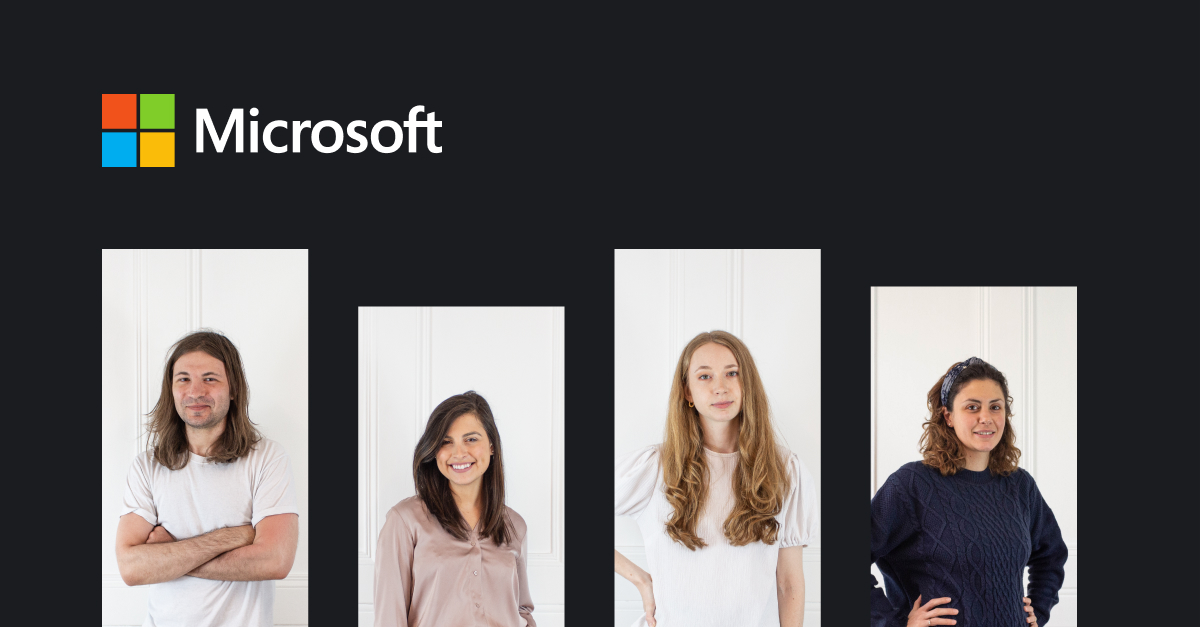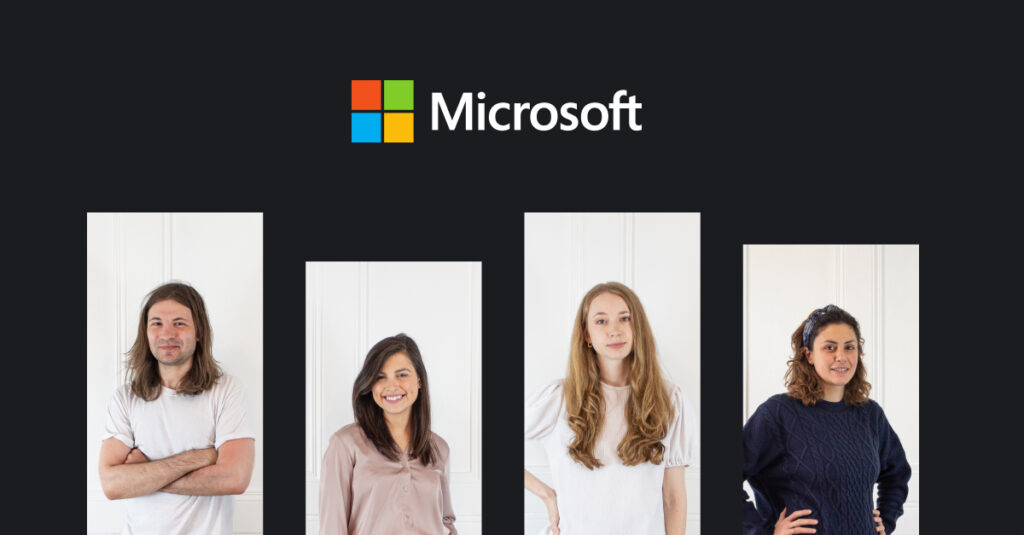Microsoft partners have a tough time standing out in a crowded market. By definition, the partner network is competitive, with many different companies selling essentially the same Microsoft products and services.
In this interview, we dive deep into the world of demand generation, including the difference between demand generation and lead generation. Four of us sat down in the basement here at Fifty Five and Five’s London Bridge HQ to chat:
- Sarah Schrum, Account Manager
- Maria Angelino, Senior Marketing Executive
- Deimantė Vaitkūnaitė, Digital Marketing Executive
- Seb Gach, Senior Writer (me)
Here, we discuss Beginnings. Where to start. How to start. Finding your unique value. Developing a strategy. I certainly learned a lot, including that I would make a terrible podcast host.

What is demand generation?
Seb: Let’s start with a definition. What is the definition of demand generation?
Sarah: Demand generation is about creating awareness. It’s the marketing activities and efforts used to create demand for a product or service that a Microsoft partner offers. Does that sound about right?
Demi: Yeah. Exactly. The goal is to generate interest in a company’s offerings and attract the interest of potential customers. So, for us, and the Microsoft partners we work with, this means content, social, paid, email marketing, and more. And this is different to lead generation. (Turns to Maria). Do you want to take that? What is the difference between lead generation and demand generation?
Maria: Sure. Lead generation is similar but more targeted and almost like the next step. It’s geared towards collecting details from people who may have already shown an interest. It’s the landing pages, CTAs, forms, etc. The two often work together.

We help created successful lead generation strategies for Microsoft Partners.
Standing out
Seb: When we work with Microsoft partners, what kinds of specific considerations do we take to make sure demand generation works for them?
Sarah: Yeah, so I think something that’s crucial as a Microsoft partner is to figure out what differentiates you from other Microsoft partners. Because a lot of the services are very similar. So, you have to ask: what do we do that sets us apart? And there’s always something. Look at your brand, your business. Then identify your unique selling points and positioning.
Demi: From an SEO standpoint that is really important. Because search terms are very similar. If you haven’t nailed what you offer that others don’t, it’s going to be tough to find the right keywords, and you might get drowned out by the competition.
Seb: How do you do that if every competitor has built their business around the same Microsoft products and services?
Maria: It depends on the needs of each client, each Microsoft partner. We start with the challenges that they help their customers to deal with on a day-to-day basis. The expertise and experience they bring.
Demi: The key is definitely finding your own angle. Really understanding your unique solution. That’s the only way to stand out from your competitors.
Maria: But they need to find an angle that feels right. One that is genuine and that really gets to the heart of what makes each business special.
Here are 4 winning moves to transform your Microsoft partner brand.
Keywords vs content
Seb: So, in terms of SEO, how would you go about this?
Demi: Forget keywords for a second. Because, as many partners will be competing for the same keywords, it’s more to do with how you present your product to the world, in your approach and especially in your content.
Seb: So, it’s always the copywriter’s fault.
Demi: Probably.
Sarah: Ha.
Maria: It’s not always the writer’s fault.
Seb: More, the person who briefed the writer.
Sarah: Don’t look at me.
Maria: No. It’s also about audience. Who you want to talk to. Why you want to talk to them. And yes, how you talk to them. There’s a lot that you need to nail down in the first place, as a strategy.
Seb: So, let’s say… well, one thing I notice is that all of this might be easier said than done. Every Microsoft partner says what makes them stand out is their expertise, their people, their dedication to their customers.
That they provide a genuine hands-on, personal approach, unlike any other Microsoft partner. And from my experience with the clients we work with that all seems pretty true. But if they are all saying that then it’s not as meaningful, surely?
Sarah: To an extent. But that’s the challenge. These things do differentiate partners, because every business, like every person that makes up that business, is different. So that expertise and experience is unique.
Maybe they have closer connections to Microsoft. Maybe they have someone on the team who worked at Microsoft. There are different certifications they can work towards. Different levels of certifications. Different approaches to solving problems. Different types of customers in different industries and success stories.
All these things tie in to create a sense of identity for each Microsoft partner. The goal is to funnel that successfully into how they present themselves in marketing materials and content.
Demi: Exactly.
Maria: And that’s why so much work goes into strategy.

Defining value
Seb: The next question was going to be about basic first steps. But should we spin that a bit and focus on strategy.
Sarah: Definitely. I have lots to add here.
Seb: Great. Because I don’t. I hate writing strategy documents.
Sarah: And that’s why we go to Ben, Emily or Will when we need a writer to work on one.
Demi: And why we have a strategy department, headed up by Barnaby.
Seb: Fair. But I mean it is quite difficult. A lot of careful thought goes into that work – and it’s something that takes real practice to get right, especially value props.
Maria: Ha. Sure. But what doesn’t? It’s also the most important thing if you want to turn your marketing success around.
Sarah: For me, getting this right is all about taking a holistic approach. Sometimes there is a disconnect between the various aspects of a marketing strategy. You know, content doing one thing. Paid campaigns doing another. A solid value prop is essential to make sure everything is joined up in a holistic way.
Nailing your unique solution, positioning, and the messaging that defines your brand is key. Once you have that in place then you can take on the different parts of your demand gen. For example, what is going on in social. What blogs are being written? Are there events being put on? All of this can be tied in together holistically if you have a solid foundation to build upon.
Best online channels. Instagram? TikTok?
Seb: How important is it to have a strong online presence on all the different social platforms? Are Microsoft partners making use of the right ones?
Sarah: I think many Microsoft partners do some aspects of digital marketing well, but they don’t necessarily always do the whole thing very well, if you know what I mean. Maybe they do some paid campaigns, but there’s no organic social, so they’re not on LinkedIn. And perhaps they’re not doing SEO. They just put all their effort into one area. But, as we know, for a demand generation strategy to be successful you have to put effort into many different facets.
Maria: Yeah. And they must work together holistically. All the different areas need to work together in tandem, rather than a company just investing in one.
Seb: Sounds a bit like a scam. If you do that, you have to do this too. And if you do that, you have to do this and this and this.
Sarah: No. Not at all.
Demi: I don’t think so. You don’t need to do everything. You just need to pick your channels wisely and see what fits your brand. For example, if everyone’s on TikTok that doesn’t mean you have to be on TikTok. You need to evaluate whether the channel is right for you.
Seb: Interesting. Should Microsoft partners be on TikTok?
Maria: Probably not.
Demi: Hmm, it depends.
Maria: Well, yeah. It depends on the company values, the brand, but mostly on the audience. Because if the audience isn’t there, then who are you talking to?
Seb: Is the TikTok audience worried about IT infrastructure?
Maria: Umm, no.
Sarah: You never know.
Demi: There might be some interest. Well, not in that specifically. There will be people who are more broadly interested in technology, for instance. You would just need to be smart about it and create a solid strategy that’s supported by data and research.
Maria: And you need to think whether that approach is right for your company. Does it fit with your brand? Is it worth spending time and effort experimenting with a channel like TikTok if your marketing is making an impact elsewhere.
Wanna know how to make your B2B business successful on TikTok? Click here.
Seb: Do we have any personal advice we can share based on how we use different platforms?
Maria: Well, we don’t have TikTok, but we do have Instagram. We mainly use Instagram for attracting new employees and showing off what’s going on at Fifty Five and Five.
Sarah: We looked at our socials and decided to keep things going on Instagram. The audience we target there is prospective hires. It’s not for lead generation. It’s about showing the employee experience. That’s what the channel is used for.
LinkedIn, on the other hand, is totally different. We have a different strategy for that and that’s more for demand generation and showcasing talent, thought leadership, and community management.
Maria: On LinkedIn you mainly showcase your professionalism. Whereas, on Instagram you can showcase your human side. And that’s a compelling angle, because, you know, behind every company, there are always a bunch of humans.
Sarah: No. We’re all robots.
Seb: I like that, Maria. A Microsoft partner can use a platform like Instagram to showcase its human side, what it’s like to work with them as a customer rather than at the organisation as an employee. That sounds like a valid and valuable route for a B2B tech company, because they might want to keep their website more professional and then use Instagram and maybe YouTube even to show what it’s like behind the scenes.
Maria: Yes. But that might also be a good tactic for the website, other channels and main messaging. It depends on the company and its values. Instagram gives a different option for tackling those aspects of the brand more directly. Being fun and friendly. Showing the culture and the get togethers. Things like that.
Target audience

Seb: How can Microsoft partners define and target the right audience?
Demi: Good question.
Sarah: That’s a thinker.
Maria: Well, it depends on what they sell.
Seb: Erm, Microsoft stuff.
Sarah: Yeah, but is it a service or a solution?
Demi: What I have found, generally, is that it is mostly senior level people from across the c-suite. So, CEO, CFO, CTO and CIO.
Maria: Yes, but I don’t think it’s always the same because here are different types of Microsoft partners. I cannot remember all the acronyms but…
Sarah: MSP, CSP, ISV.
Maria: Yep. You know, some resell the actual Microsoft products, others create their own tools and IPs that, for instance, might enhance the Microsoft 365 experience in some way.
So that’s why I say it’s not just senior people. Yes the decision makers in charge of budget are always crucial. You can’t leave them out. But essentially there are different technical levels on the IT side that can be targeted. The technical person or whoever’s the owner of deploying that tool needs to know how it works, what pain points it alleviates, basically whether or not it’s going to be a useful addition to the company’s tech stack.
They might not know much about budget, and they might not have a say in the final decision, but they are the ones who will champion your solution or services to the higher ups. You know, spread the word.
Demi: And don’t forget, you need to tailor the content and messaging for those people. That’s where you run unique campaigns for each audience with messaging for each and perhaps testing out the different platforms for different roles. Coming up with a campaign strategy.
Seb: Where the fun starts.
Demi: Exactly.
We can help you create the most effective B2B content marketing strategies.
Best thing about working with Microsoft partners
Seb: Final question. What have you enjoyed most about working with Microsoft partners?
Demi: There are many elements, but I think when campaigns succeed, you feel really happy about it because you have contributed to the client’s success. You made it become a reality.
Planning the strategy is another thing I love. Just because you’re looking and thinking about everything together, putting all the pieces in place. You’re collaborating with other people, which I really like as well.
Seb: I know yours, Sarah, is getting to meet lots of people, networking, and developing professional relationships. All those fantastic meetings you have hosted.
Sarah: Ha. Yeah, I really have enjoyed meeting all the different Microsoft partners, building relationships and seeing the brands grow.
Maria: Yeah, I think I pretty much agree with Demi. I enjoy putting together the actual strategy for Microsoft partners and finding a way to get results that blow them away. That’s when it feels good, and everyone is happy.
Seb: Lovely. That seems like a nice place to stop. Thanks everyone.
Want more similar content?
Stay informed on the latest trends, tips and insights in all things marketing for Microsoft partners. Subscribe to our FREE, monthly newsletter and stay ahead of the competition. Sign up now!

